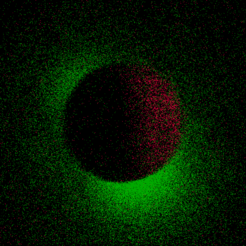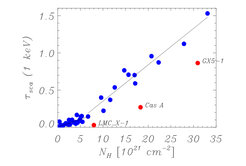1000 citations for dust scattering halos

In the centre of the image, you can see the moon in dark red, which eclipses bright source Sco-X1. This very rare constellation allows it to directly observe the faint X-ray halo of Sco-X1 (in green).
Gas and dust between a distant astronomical source and the observer will absorb and scatter part of the emission. The scattering on the interstellar dust particles occurs at small angles for short wavelengths, X-ray sources are therefore surrounded by a "halo" of scattered radiation – the same effect that produces a halo around the moon on a hazy night. (In this case, the lunar light is scattered by tiny particles in the Earth’s atmosphere.)
While this “extinction” (both absorption and scattering) might seriously hamper observations at optical wavelengths, X-ray observations offer the unique advantage that both components can be measured independently of each other and in one observation: the absorption by the spectrum, the scattering from the distribution of the surface brightness.
While using X-rays to study the intergalactic medium had been discussed already in 1960s and the first detections were made in the 1980s, the ROSAT X-ray satellite was the first telescope to make this method actually feasible: Its background detector noise (caused by charged particles) was extremely small and it had a much higher energy resolution than previous X-ray telescopes.

The correlation between scattering depth and absorption shows that basically all heavy elements are part of the dust. The three outliers are intrinsically absorbed.
In a systematic investigation of X-ray sources observed with ROSAT, the authors determined important basic relations between the optical reddening, X-ray absorption and X-ray scattering. From this they were able to obtain the amount of gas (mainly hydrogen), the amount of dust, and the ratio of gas and dust in the interstellar medium. Including also optical measurements, even some physical properties of the dust grains could be obtained.
These basic relations are probably the reason why this paper keeps being cited: there was a steady increase from 1995 to 2000 and since then the number of citations has been roughly constant each year. This makes it the most cited paper about a scientific result from the ROSAT mission.













